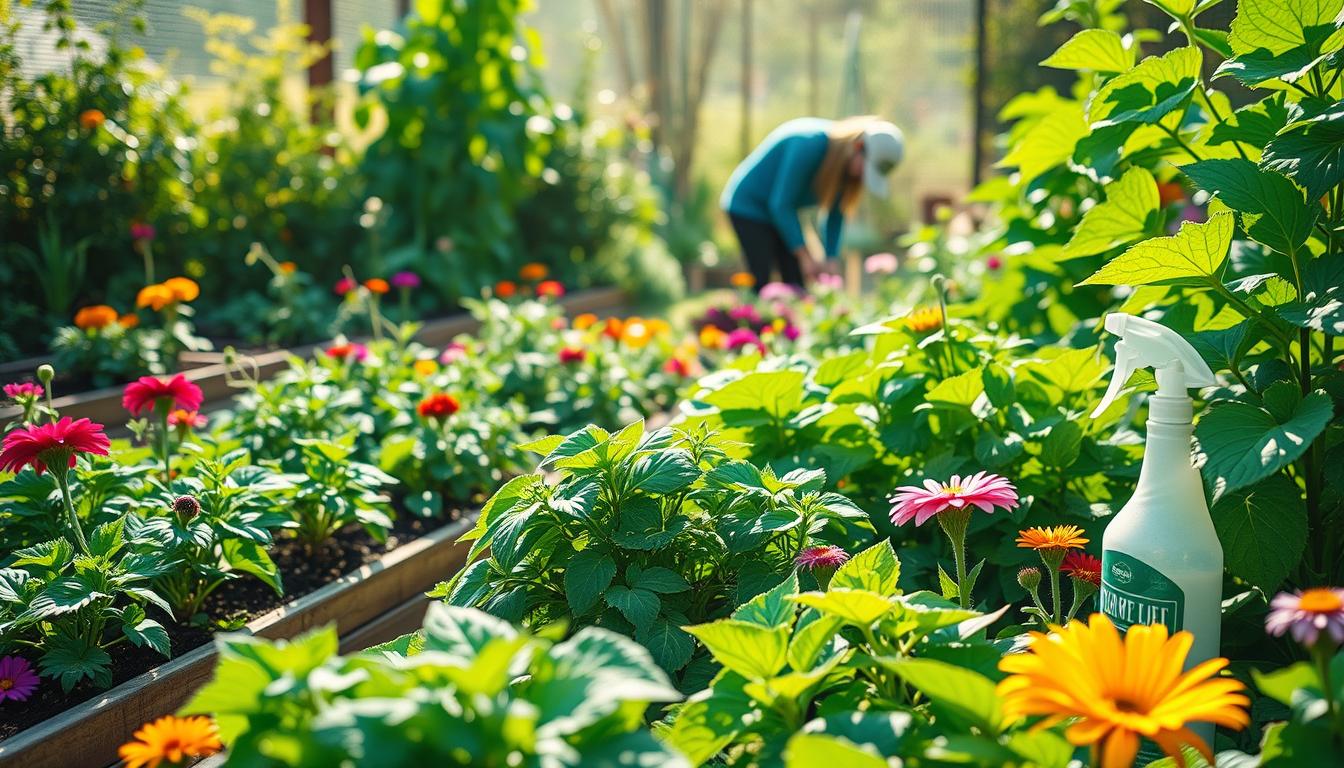As a gardener, I’ve learned that stopping plant diseases is key to a healthy garden. Keeping diseases away is a big part of my gardening routine. I’m excited to share my tips with you. Follow my strategies to keep your plants healthy and enjoy a great harvest.
First, it’s important to understand why we need to protect our plants. By taking the right steps, we can stop diseases and keep our gardens healthy. In this article, I’ll share everything you need to know about preventing plant diseases. This way, you can keep your garden thriving with effective methods.
Understanding Common Plant Diseases
To keep my plants healthy, I need to know about common plant diseases and their causes. Plant health tips help prevent disease spread. Choosing disease-resistant plants is key to a healthy garden. Recognizing signs like yellow leaves or black spots helps me act fast.
Fungal, bacterial, and viral infections are common plant diseases. Fungal infections often come from too much water. Bacterial infections spread through contaminated soil or water. Viral infections can spread through insects or tools.
What to Look Out For
- Yellowing or browning leaves
- Black spots or powdery patches on leaves
- Soft or mushy stems
- White, cottony growth on leaves or stems
Signs of Plant Stress
Stressed plants are more likely to get sick. Signs include wilting, yellow leaves, and slow growth. Fixing stress causes like too little or too much water helps prevent disease.
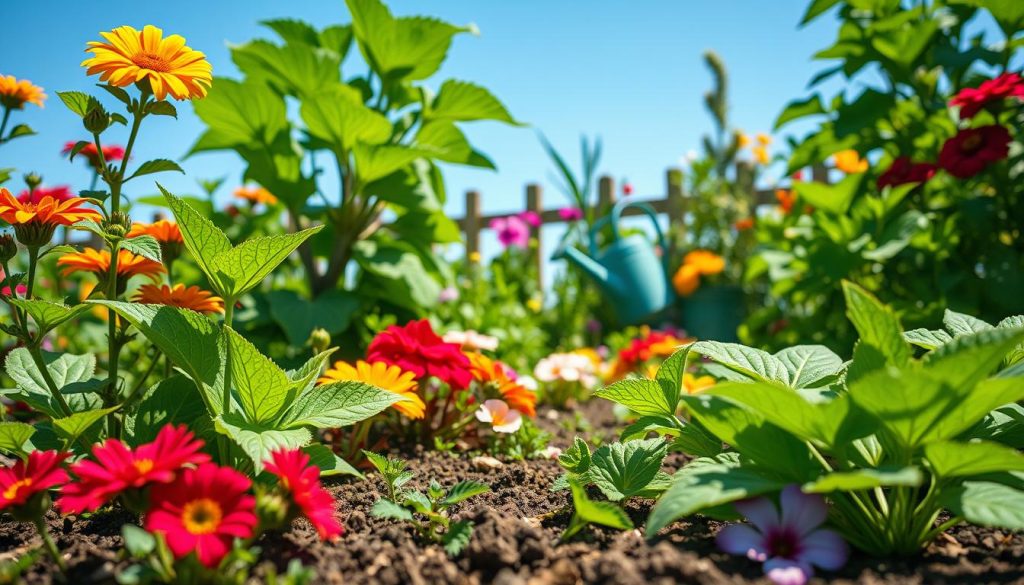
The Role of Fungi and Bacteria
Fungi and bacteria are big players in plant diseases. Fungi can cause root rot and leaf spots. Bacteria lead to leaf blight and crown gall. Knowing their role helps me prevent their spread and protect my plants.
Choosing Disease-Resistant Plant Varieties
As a gardener, picking disease-resistant plants is key to stopping plant diseases. This method helps control diseases and prevent them in gardens. By choosing plants with natural defenses, I lower disease risks and cut down on chemical use.
Tomatoes, peppers, and cucumbers are good examples of disease-resistant plants. They’ve been bred to fight off diseases. Adding these to my garden makes it healthier and more resistant to diseases.
Benefits of Disease Resistance
Disease-resistant plants have many advantages. They lower disease risks and need less pesticides. This also helps keep the garden balanced and healthy. Plus, they grow well in many conditions, making them perfect for all gardeners.
Recommended Disease-Resistant Plants
Here are some top picks for disease-resistant plants:
- Tomatoes with resistance to fusarium wilt and nematodes
- Peppers with resistance to tobacco mosaic virus and bacterial leaf spot
- Cucumbers with resistance to powdery mildew and scab
By picking these plants, I can have a thriving garden with less disease risk. This is crucial for controlling and preventing diseases in gardens.
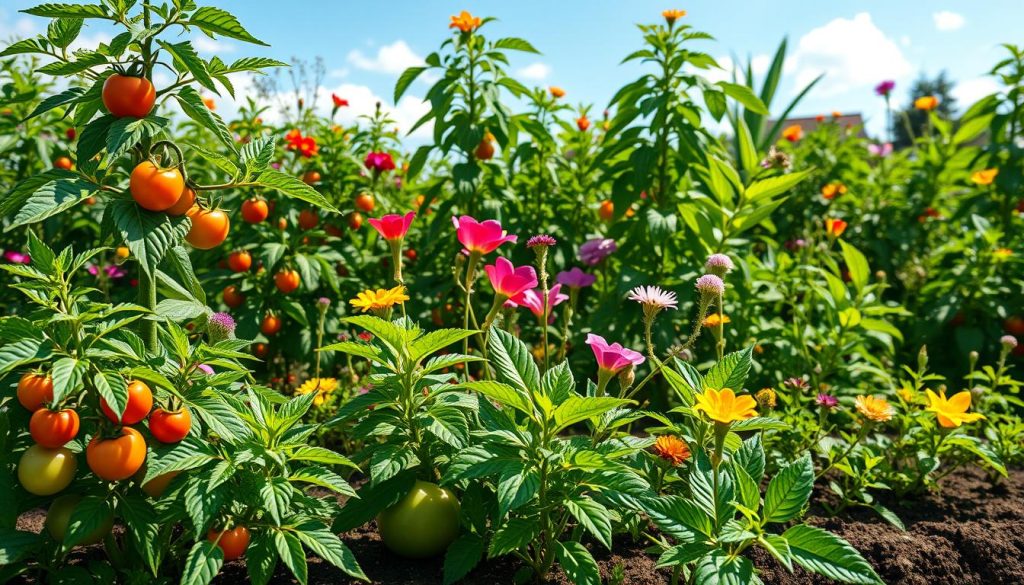
The Importance of Proper Watering Practices
Proper watering is key in keeping plants healthy. It’s important to water them at the right time and amount. Too much water can cause root rot, while too little can stress plants and make them sick.
When watering my plants, I think about a few things. These include the plant type, soil moisture, and the weather. Here are some tips to remember:
- Check the soil moisture by sticking your finger into the soil up to the first knuckle.
- Water plants in the morning to allow the plants to absorb the water throughout the day.
- Avoid getting water on the leaves or crown of the plant to prevent creating an ideal environment for diseases to thrive.
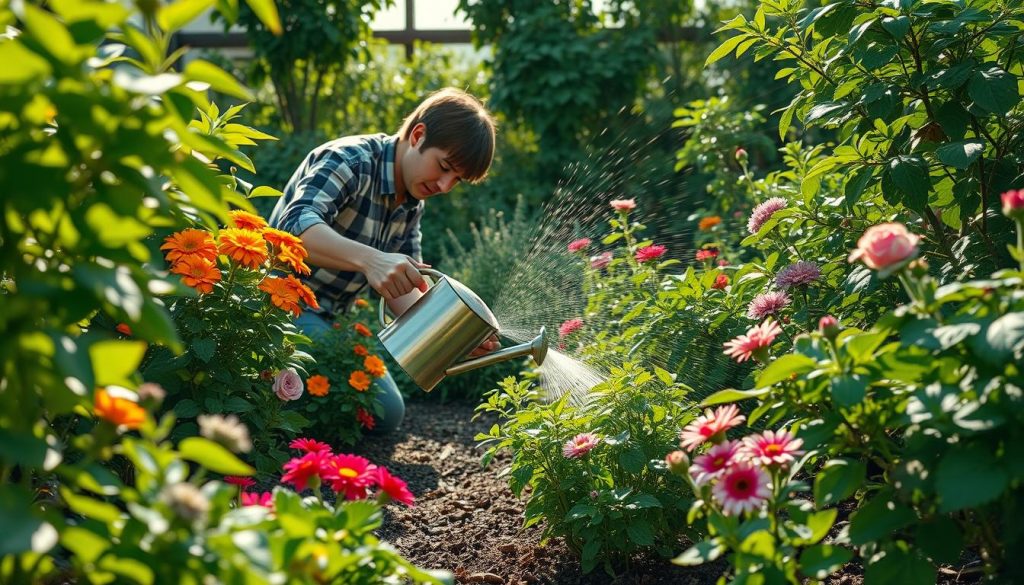
By following these tips, I can prevent diseases caused by water and keep the roots healthy. This is a big part of keeping plants safe from diseases. Being careful with watering helps my plants stay strong and healthy.
| Watering Tips | Benefits |
|---|---|
| Water plants in the morning | Allows plants to absorb water throughout the day |
| Check soil moisture | Prevents overwatering and underwatering |
| Avoid getting water on leaves or crown | Prevents creating an ideal environment for diseases to thrive |
Creating a Healthy Soil Environment
To stop plant fungal infections, making the soil healthy is key. Add compost or manure to balance the ecosystem and help plants grow well. This is a great way to keep your garden healthy for a long time.
A healthy soil is vital for stopping plant diseases. Soil tests show the pH and nutrients, helping you adjust. Look for the pH level and nutrient content in your soil test.
- pH level: Most plants like a slightly acidic to neutral soil pH, between 6.0 and 7.0.
- Nutrient content: Check the levels of nitrogen, phosphorus, and potassium, as they’re crucial for growth.
Keeping the soil healthy stops fungal infections and other diseases. This is a big step in keeping your plants healthy. 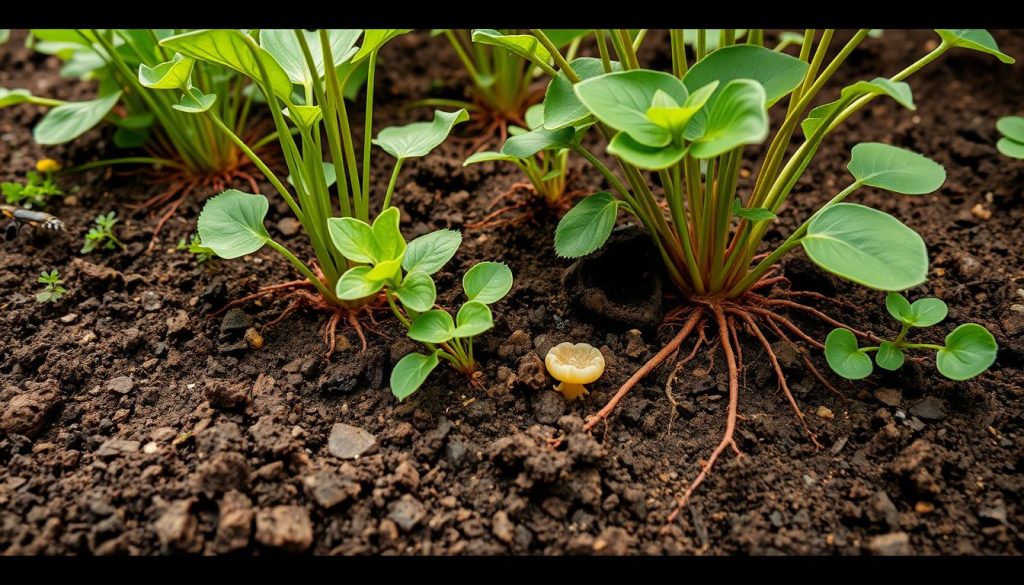
The Role of Organic Matter
Organic matter is very important for a healthy soil. It makes the soil better, holds more water, and gives plants nutrients. Examples include compost, manure, and leaf mold.
Soil Tests That I Recommend
There are many soil tests, like DIY kits and lab tests. I suggest using both for a full picture of your soil’s health. By following these tips and making the soil healthy, you’ll prevent fungal infections and grow strong plants.
Utilizing Crop Rotation in My Garden
Crop rotation is a simple yet effective way to prevent plant diseases and promote soil health. By rotating my crops, I can break the disease cycle and prevent the buildup of pathogens in the soil. This technique also adds organic matter and reduces the need for fertilizers and pesticides, creating a diverse and resilient ecosystem that is less susceptible to diseases.
To implement crop rotation, I consider the types of plants that are disease-resistant and how they can be rotated to control plant diseases. For example, rotating between plants that are susceptible to different types of diseases can help prevent the spread of disease. I also consider the benefits of crop rotation for soil health, including improved soil structure and increased nutrient availability.
How Crop Rotation Works
Crop rotation involves rotating different types of plants in a specific sequence to achieve the desired benefits. This can include rotating between plants that are heavy feeders and those that are light feeders, or between plants that are susceptible to different types of diseases. By rotating my crops, I can create a balanced and diverse ecosystem that is better equipped to resist disease and promote healthy plant growth.
Benefits for Soil Health
The benefits of crop rotation for soil health are numerous. By adding organic matter and reducing the need for fertilizers and pesticides, crop rotation can help improve soil structure and increase nutrient availability. This can lead to healthier plants that are better equipped to resist disease and promote a balanced ecosystem. Some of the key benefits of crop rotation for soil health include:
- Improved soil structure
- Increased nutrient availability
- Reduced need for fertilizers and pesticides
- Increased crop yields
Implementing Companion Planting Strategies
I’ve been looking for ways to keep my garden healthy. Companion planting is a great method. It pairs plants that help each other grow or keep pests away. This way, I can stop diseases and pests from spreading, which is key to a healthy garden.
Best Companion Plants for Disease Prevention
Marigolds, basil, and garlic are top picks for keeping diseases away. Marigolds fight nematodes, basil makes nearby plants taste better and keeps them healthy. Garlic has natural antifungal powers that stop diseases from spreading. Adding these plants to my garden makes it a balanced, diverse place less likely to get sick.
My Favorite Pairings
I love pairing marigolds with tomatoes and basil with peppers. These combos not only fight off diseases but also make my plants taste better and grow stronger. Using companion planting helps me avoid using harmful chemicals and makes my garden a healthier place.
Here are some more pairings to try:
- Planting garlic with roses to prevent aphids and other pests
- Planting basil with lettuce to improve flavor and prevent disease
- Planting marigolds with carrots to repel nematodes and other pests
Maintaining Clean Garden Tools and Equipment
To keep plants healthy, it’s key to keep garden tools and equipment clean. Dirty tools can spread diseases from one plant to another. By cleaning your tools, you lower the chance of disease in your garden.
So, how do you keep your tools and equipment spotless? Here are a few tips:
- Use a mixture of water and bleach to sterilize your tools
- Wash your hands before and after handling plants
- Regularly clean and disinfect any equipment that comes into contact with plants
How to Sterilize My Tools
Sterilizing your tools is easy to do at home. Mix water and bleach to create a solution that kills bacteria and fungi. Soak your tools in it for a few minutes, then rinse well with clean water.
Why Clean Tools Matter
Clean tools and equipment are vital for stopping plant diseases. By keeping them clean, you stop pathogens from spreading. This keeps your plants healthy, especially if they’re prone to diseases.
| Tool | Cleaning Method |
|---|---|
| Pruning shears | Sterilize with bleach solution |
| Gardening gloves | Wash with soap and water |
| Watering can | Disinfect with vinegar solution |
Recognizing Pest Control’s Role in Disease Prevention
As I tend to my garden, I’ve learned that pest control is key to stopping plant diseases. By controlling pests well, I lower the chance of diseases spreading. This keeps my garden healthy and balanced.
I’ve found Integrated Pest Management (IPM) strategies helpful. They mix different ways to manage pests. For example, I use crop rotation, companion planting, and natural controls like neem oil and diatomaceous earth. These methods help my plants stay strong and disease-free.
Effective Pest Control Methods
- Crop rotation to break pest cycles
- Companion planting to deter pests
- Biological control using natural predators
- Natural pest control solutions like neem oil and diatomaceous earth
Using these methods has greatly reduced pests and diseases in my garden. This keeps my garden healthy and my plants strong against diseases.
Monitoring Plant Health Regularly
To stop garden diseases, it’s key to watch plant health closely. I check my plants every day for signs of trouble. This way, I can catch problems early and stop them from getting worse.
Stopping plant diseases means being ready to act. Keeping a plant journal is a great way to do this. In my journal, I write down how my plants are doing and any issues I see. This helps me spot patterns and act fast to stop disease.
Keeping a Plant Journal
A plant journal is a simple but useful tool. It lets me track my plants’ health and spot problems early. I write down the date, weather, and any changes I see in my plants.
The Power of Observation
Watching your plants closely is very important. By doing this, I can see signs of trouble like yellow leaves or black spots. If I see these signs, I act fast to stop the disease from spreading.
Watching and acting quickly are crucial for keeping plants healthy. By being proactive, I can make sure my garden stays disease-free and my plants thrive.
- Monitor plant health daily
- Keep a plant journal to track progress and identify potential issues
- Observe plants regularly to detect signs of stress or disease
- Take prompt action to prevent the spread of disease
| Plant Health Indicator | Description |
|---|---|
| Yellowing leaves | May indicate nutrient deficiency or disease |
| Black spots | May indicate fungal disease |
| Powdery mildew | May indicate fungal disease |
Seeking Professional Help When Needed
While we’ve talked about many ways to prevent plant diseases, sometimes you need expert advice. If you’re dealing with ongoing disease problems or aren’t sure what to do, reach out to your local extension office or a gardening expert you trust. They can give you specific advice and help you create a plan to keep your garden healthy.
Also, there are many reliable online resources like gardening forums, blogs, and websites. These can offer useful tips and insights on preventing plant diseases. By staying informed and getting professional help when needed, you can keep your garden healthy and vibrant for many years.

